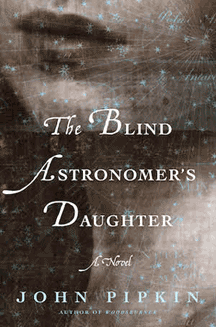Exclusive interview with author John Pipkin about his new novel featuring a girl who takes over where her father left off to advance astronomy
Rating: Three Stars
Review Gabrielle Pantera
 “I first began thinking about the central ideas of this novel during a trip to Ireland several years ago,” says The Blind Astronomer’s Daughter author John Pipkin. “I was in graduate school, researching the poets of the late-eighteenth and early-nineteenth centuries in the collections at the National Library of Ireland in Dublin. During a visit to the ruins of the poet Mary Tighe’s house in Inistioge, Kilkenny, I began thinking about the concurrence of historical events like the Irish Rebellion of 1798, the Romantic Period, and the dawn of modern science and astronomy.”
“I first began thinking about the central ideas of this novel during a trip to Ireland several years ago,” says The Blind Astronomer’s Daughter author John Pipkin. “I was in graduate school, researching the poets of the late-eighteenth and early-nineteenth centuries in the collections at the National Library of Ireland in Dublin. During a visit to the ruins of the poet Mary Tighe’s house in Inistioge, Kilkenny, I began thinking about the concurrence of historical events like the Irish Rebellion of 1798, the Romantic Period, and the dawn of modern science and astronomy.”
The Blind Astronomer’s Daughter is Caroline, adopted as a baby after astronomer Arthur Ainsworth and his wife lose their twin baby girls. As Caroline grows up she helps her father with his obsession, living a sheltered life aiding her father and peering through her own telescope at the sky and the world around her. Family tragedy soon follows when the tortured Arthur kills himself, and Caroline must leave Ireland for London, also abandoning Finnegan O’Siodha, the local blacksmith with whom she has fallen in love. She later discovers her father’s legacy for her: not just the wreck of an unfinished telescope, but a cryptic atlas which holds the secret to finding new worlds. She must navigate her way not just through scientific inquiry and unfulfilled love, but deal with the political currents of Ireland in rebellion.
This is an inspiring story of a woman who advances astronomy behind the scenes by making the mirrors used in telescopes. And adding to the intriguing framework the author has given Caroline a physical disability. The story jumps around quite a bit, across time frame and location. It could have been more engaging if it was just about the heroine Caroline and her impressions of all around her.
“I’ve been living with these characters and their stories for quite awhile,” says Pipkin. “The novel involves multiple interwoven plot lines that developed over time. Some of the characters did not begin to find their way into the story until the third or fourth draft. This is my second novel, but the ideas for the story actually preceded my first book.”
Pipkin did his book research at the National Library of Ireland in Dublin, at the British Library in London, and at the Harry Ransom Center at the University of Texas at Austin. “The Herschel Family Papers at the Harry Ransom Center provided a wealth of information and inspiration about the brother-sister astronomers William and Caroline Herschel, including the handwritten journals of Caroline, and a collection of little note cards looped with string, which appear in the novel.”
Pipkin’s first novel, Woodsburner, is an historical novel inspired by the forest fire accidentally started by Henry David Thoreau in 1844 in the woods of Concord, Massachusetts. The book won the NYC Center for Fiction’s First Novel Prize, The Texas Institute of Letters Steven Turner First Novel Prize, and the Massachusetts Center for the Book Novel Prize. It was named One of the Best Books of 2009 by the San Francisco Chronicle, the Washington Post, and the Christian Science Monitor.
Pipkin teaches creative writing and literature at Southwestern University and is currently working on a novel about the Tour de France and the history of cycling. He was born in Baltimore and has lived in Austin, Texas, since 2000. He can be found online at: www.johnpipkin.com; twitter: @john_pipkin or facebook/John-Pipkin
The Blind Astronomer’s Daughter by John Pipkin. Hardcover: 480 pages, Publisher: Bloomsbury USA (October 11, 2016), Language: English, ISBN: 9781632861870 $28.00
